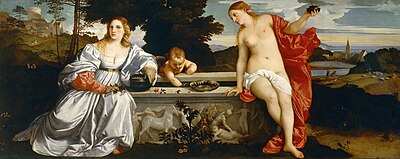 |
| Titian, Sacred and Profane Love, c. 1513 – 1514 ORIGINS OF RENAISSANCE ART The origins of Renaissance art can be traced to Italy in the late 13th and early 14th centuries. During this so-called “proto-Renaissance” period (1280-1400), Italian scholars and artists saw themselves as reawakening to the ideals and achievements of classical Roman culture. Writers such as Petrarch (1304-1374) and Giovanni Boccaccio (1313-1375) looked back to ancient Greece and Rome and sought to revive the languages, values and intellectual traditions of those cultures after the long period of stagnation that had followed the fall of the Roman Empire in the sixth century. |
The Florentine painter Giotto (1267?-1337), the most famous artist of the proto-Renaissance, made enormous advances in the technique of representing the human body realistically. His frescoes were said to have decorated cathedrals at Assisi, Rome, Padua, Florence and Naples, though there has been difficulty attributing such works with certainty
EARLY RENAISSANCE ART (1401-1490S)
In the later 14th century, the proto-Renaissance was stifled by plague and war, and its influences did not emerge again until the first years of the next century. In 1401, the sculptor Lorenzo Ghiberti (c. 1378-1455) won a major competition to design a new set of bronze doors for the Baptistery of the cathedral of Florence, beating out contemporaries such as the architect Filippo Brunelleschi (1377-1446) and the young Donatello (c. 1386- 1466), who would later emerge as the master of early Renaissance sculpture.
| The Last Supper |
PIETA
Renaissance art is the painting, sculpture and decorative arts of that period of European history known as the Renaissance, emerging as a distinct style in Italy in about 1400, in parallel with developments which occurred in philosophy, literature, music and science. Renaissance art, perceived as a royalty of ancient traditions, took as its foundation the art of Classical antiquity, but transformed that tradition by the absorption of recent developments in the art of Northern Europe and by application of contemporary scientific knowledge. Renaissance art, withRenaissance Humanist philosophy, spread throughout Europe, affecting both artists and their patrons with the development of new techniques and new artistic sensibilities. Renaissance art marks the transition of Europe from the medieval period to the Early modern age.
In many parts of Europe, Early Renaissance art was created in parallel with Late Medieval art.
Prof.Ed.7b (mw 1:00-2:30)
TumugonBurahinGroup: Maria Rhodora Sanchez
Rhodora Dasco
Christine Rioveros
Mary Hazel Tating
Christine Marmol